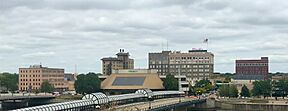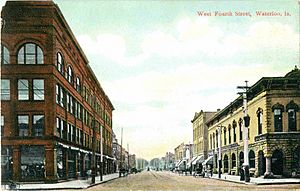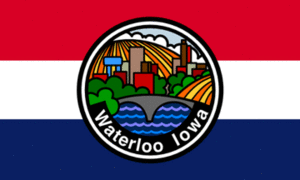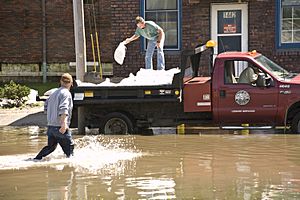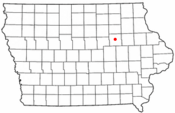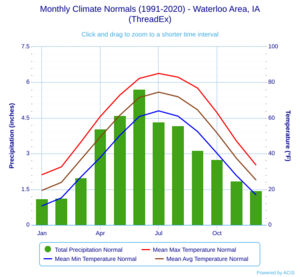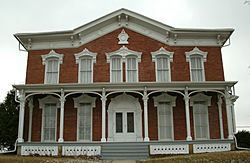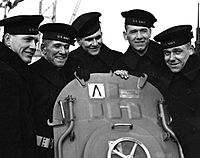Waterloo, Iowa facts for kids
Quick facts for kids
Waterloo, Iowa
|
|||
|---|---|---|---|
|
From left to right, from top: Downtown, Waterloo Convention Center, Waterloo Building, Waterloo Public Library, Mount Moriah Baptist Church, and Waterloo City Hall
|
|||
|
|||
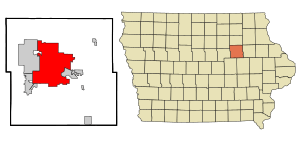
Location within Black Hawk County and Iowa
|
|||
| Country | |||
| State | |||
| County | Black Hawk | ||
| Incorporated | 1868 | ||
| Area | |||
| • City | 63.43 sq mi (164.29 km2) | ||
| • Land | 61.59 sq mi (159.53 km2) | ||
| • Water | 1.84 sq mi (4.76 km2) | ||
| Elevation | 883 ft (269 m) | ||
| Population
(2020)
|
|||
| • City | 67,314 | ||
| • Rank | 8th in Iowa | ||
| • Density | 1,092.85/sq mi (421.95/km2) | ||
| • Metro | 169,895 | ||
| Time zone | UTC−6 (CST) | ||
| • Summer (DST) | UTC−5 (CDT) | ||
| ZIP codes |
50701-50707
|
||
| Area code | 319 | ||
| FIPS code | 19-82425 | ||
| GNIS ID | 468951 | ||
Waterloo is a city in Black Hawk County, Iowa, United States. It is the county seat. In 2020, about 67,314 people lived there. This makes it the eighth-largest city in Iowa.
Waterloo is part of a larger area with its neighbor, Cedar Falls. This area is called the Waterloo-Cedar Falls Metropolitan Statistical Area. Waterloo is the bigger of the two cities.
Contents
History of Waterloo
Waterloo was first called Prairie Rapids Crossing. It was settled in 1845 by George and Mary Melrose Hanna. They came to the east bank of the Cedar River. Other families, like the Virdens and Mullans, followed in 1846. You can still see their names on streets like Hanna Boulevard and Mullan Avenue.
The city's name changed to Waterloo after Charles Mullan asked for a post office. He chose the name Waterloo from a list of other post offices.
Waterloo grew a lot in two main periods. From 1895 to 1915, its population grew by 290%. From 1925 to 1960, it grew from about 36,000 to 71,000 people. During these times, factories, railroads, and wholesale businesses grew. Companies like the Waterloo Gasoline Traction Engine Company and the Rath Packing Company moved to Waterloo. The Illinois Central Railroad was also a big employer.
In 1934, a famous bank robber named Tommy Carroll was involved in a shootout in Waterloo. He was injured and later died at a local hospital.
Waterloo faced tough times in the 1980s. Many jobs were lost because the main industries were linked to farming. John Deere, a large employer, cut 10,000 jobs. The Rath meatpacking plant closed, losing 2,500 jobs. The city's population dropped by about 14% then. Today, Waterloo has many different types of businesses. John Deere is still important, but it employs fewer people than before.
African American Community and Civil Rights
In the early 1900s, black railroad workers came to Waterloo. They were often limited to living in a specific area, which is still known as the east side today. More black workers came in the 1940s to work at the Rath meat plant.
In the 1950s, unions like the United Packinghouse Workers of America welcomed black workers. Leaders like Anna Mae Weems, Ada Treadwell, Charles Pearson, and Jimmy Porter worked to fight against unfair treatment. They organized protests against places that discriminated against black people.
Jimmy Porter later started the first black radio station in Waterloo, KBBG, in 1978. Anna Mae Weems became a leader in the anti-discrimination movement and the local NAACP chapter.
In 1966, after a suspicious death in jail, the black community protested. Anna Mae Weems led a march to city hall. This led to the creation of the Waterloo Human Rights Commission.
A 1967 report called "Waterloo's Unfinished Business" showed problems in housing, education, and jobs for the black community. It found that schools were often separated by race. It also showed that many black residents had service jobs. Years later, some of these issues still remained.
The Iowa Supreme Court made school segregation illegal in 1868. But in 1967, many schools in Waterloo were still segregated. The city tried to encourage integration, but it was a slow process.
Protests in the 1960s
By the 1960s, jobs were harder to find. Young black residents felt they were treated unfairly. In 1967, 95% of the black population lived in "East" Waterloo. While some thought East High School was integrated, other schools in East Waterloo had almost no white students.
Young black people, aged 16–25, organized protests. Sometimes, these protests turned into riots when people felt their voices weren't heard. In July and September 1968, buildings were damaged.
In September 1968, students at East High School protested about unfair treatment and asked for changes, like teaching African American history. During a football game, a conflict with police led to a larger riot. The National Guard was called in to help.
Waterloo Today
In 2009, a report found Waterloo to be Iowa's most segregated city. It said that old patterns of racial separation still existed. In 2015, a national news site listed Waterloo as one of the worst cities for black Americans. It noted a high unemployment rate for black residents compared to white residents.
In 2012, a police shooting caused more protests in the community.
Flood of 2008
In June 2008, Waterloo and Cedar Falls had their worst flood ever. The flood control system built in earlier years helped a lot.
Waterloo's Geography
Waterloo covers about 63 square miles (164 square kilometers). Most of this area is land, with a small part being water. The city is about 846 feet above sea level.
Climate
Waterloo has a typical Iowa climate, with warm summers and cold winters. The average temperature in January is about 19 degrees Fahrenheit (-7 Celsius). In July, it's about 74 degrees Fahrenheit (23 Celsius).
- It gets very cold, with about 22 nights a year below 0 degrees Fahrenheit (-18 Celsius).
- It gets hot, with about 16 days a year above 90 degrees Fahrenheit (32 Celsius).
- The growing season for plants lasts about 154 days.
- The coldest temperature ever recorded was -34 degrees Fahrenheit (-37 Celsius).
- The hottest temperature ever recorded was 112 degrees Fahrenheit (44 Celsius).
Waterloo gets about 36 inches (920 mm) of rain each year. Most rain falls in spring and summer. The wettest month on record was July 1999.
Winters bring moderate snowfall, averaging about 39 inches (99 cm) per season. Snow usually covers the ground for about 67 days, mostly from December to March.
| Climate data for Waterloo Regional Airport (1991–2020 normals, extremes 1895–present) | |||||||||||||
|---|---|---|---|---|---|---|---|---|---|---|---|---|---|
| Month | Jan | Feb | Mar | Apr | May | Jun | Jul | Aug | Sep | Oct | Nov | Dec | Year |
| Record high °F (°C) | 65 (18) |
78 (26) |
87 (31) |
100 (38) |
108 (42) |
107 (42) |
112 (44) |
110 (43) |
102 (39) |
95 (35) |
83 (28) |
74 (23) |
112 (44) |
| Mean maximum °F (°C) | 47.5 (8.6) |
51.7 (10.9) |
70.5 (21.4) |
82.7 (28.2) |
88.8 (31.6) |
93.3 (34.1) |
94.3 (34.6) |
91.7 (33.2) |
90.6 (32.6) |
82.9 (28.3) |
67.5 (19.7) |
51.5 (10.8) |
95.9 (35.5) |
| Mean daily maximum °F (°C) | 28.2 (−2.1) |
32.6 (0.3) |
46.5 (8.1) |
60.9 (16.1) |
72.8 (22.7) |
82.2 (27.9) |
85.0 (29.4) |
82.9 (28.3) |
76.8 (24.9) |
63.0 (17.2) |
47.1 (8.4) |
33.7 (0.9) |
59.3 (15.2) |
| Daily mean °F (°C) | 19.4 (−7.0) |
23.9 (−4.5) |
36.7 (2.6) |
49.4 (9.7) |
61.5 (16.4) |
71.5 (21.9) |
74.5 (23.6) |
71.9 (22.2) |
64.6 (18.1) |
51.6 (10.9) |
37.4 (3.0) |
25.3 (−3.7) |
49.0 (9.4) |
| Mean daily minimum °F (°C) | 10.7 (−11.8) |
15.2 (−9.3) |
26.9 (−2.8) |
37.9 (3.3) |
50.2 (10.1) |
60.8 (16.0) |
64.0 (17.8) |
61.0 (16.1) |
52.4 (11.3) |
40.2 (4.6) |
27.7 (−2.4) |
17.0 (−8.3) |
38.7 (3.7) |
| Mean minimum °F (°C) | −16.0 (−26.7) |
−9.8 (−23.2) |
2.2 (−16.6) |
20.4 (−6.4) |
32.9 (0.5) |
45.7 (7.6) |
51.2 (10.7) |
48.2 (9.0) |
34.7 (1.5) |
21.5 (−5.8) |
7.9 (−13.4) |
−7.3 (−21.8) |
−19.6 (−28.7) |
| Record low °F (°C) | −34 (−37) |
−31 (−35) |
−34 (−37) |
−4 (−20) |
22 (−6) |
33 (1) |
42 (6) |
33 (1) |
19 (−7) |
0 (−18) |
−17 (−27) |
−29 (−34) |
−34 (−37) |
| Average precipitation inches (mm) | 1.10 (28) |
1.14 (29) |
1.98 (50) |
4.04 (103) |
4.61 (117) |
5.72 (145) |
4.34 (110) |
4.17 (106) |
3.14 (80) |
2.76 (70) |
1.85 (47) |
1.44 (37) |
36.29 (922) |
| Average snowfall inches (cm) | 10.1 (26) |
9.3 (24) |
4.6 (12) |
1.7 (4.3) |
0.1 (0.25) |
0.0 (0.0) |
0.0 (0.0) |
0.0 (0.0) |
0.0 (0.0) |
0.3 (0.76) |
3.1 (7.9) |
9.9 (25) |
39.1 (99) |
| Average precipitation days (≥ 0.01 in) | 8.1 | 8.0 | 10.1 | 11.5 | 12.9 | 11.8 | 8.9 | 8.8 | 8.7 | 8.5 | 8.1 | 8.4 | 113.8 |
| Average snowy days (≥ 0.1 in) | 6.8 | 6.3 | 3.2 | 1.1 | 0.1 | 0.0 | 0.0 | 0.0 | 0.0 | 0.4 | 2.5 | 6.2 | 26.6 |
| Average relative humidity (%) | 73.0 | 73.8 | 72.7 | 66.4 | 65.7 | 67.7 | 71.9 | 73.7 | 73.7 | 69.9 | 74.8 | 77.2 | 71.8 |
| Average dew point °F (°C) | 14.0 (−10.0) |
18.9 (−7.3) |
30.4 (−0.9) |
42.1 (5.6) |
52.9 (11.6) |
62.1 (16.7) |
66.4 (19.1) |
64.0 (17.8) |
56.1 (13.4) |
45.0 (7.2) |
32.7 (0.4) |
19.6 (−6.9) |
42.0 (5.6) |
| Source: NOAA (relative humidity and dew point 1961–1990) | |||||||||||||
People of Waterloo
| Historical population | |||
|---|---|---|---|
| Census | Pop. | %± | |
| 1870 | 4,337 | — | |
| 1880 | 5,630 | 29.8% | |
| 1890 | 6,674 | 18.5% | |
| 1900 | 12,580 | 88.5% | |
| 1910 | 26,693 | 112.2% | |
| 1920 | 36,230 | 35.7% | |
| 1930 | 46,191 | 27.5% | |
| 1940 | 51,743 | 12.0% | |
| 1950 | 65,198 | 26.0% | |
| 1960 | 71,755 | 10.1% | |
| 1970 | 75,533 | 5.3% | |
| 1980 | 75,985 | 0.6% | |
| 1990 | 66,467 | −12.5% | |
| 2000 | 68,747 | 3.4% | |
| 2010 | 68,406 | −0.5% | |
| 2020 | 67,314 | −1.6% | |
| Iowa Data Center | |||
In 2020, Waterloo had 67,314 people. The city's population density was about 1,092 people per square mile.
- About 72.4% of the people were White.
- About 17.3% were Black or African American.
- About 2.5% were Asian.
- About 7.1% of the population was Hispanic or Latino.
In 2010, there were 68,406 people living in Waterloo. There were 28,607 households. About 30% of households had children under 18. The average age in the city was 35.9 years.
Waterloo is part of a larger metropolitan area with Cedar Falls. This area includes Black Hawk, Bremer, and Grundy counties. In 2008, about 164,220 people lived in this larger area.
Major employers in the Waterloo/Cedar Falls area include:
- John Deere
- Tyson Fresh Meats
- University of Northern Iowa
- Omega Cabinetry
- Bertch Cabinet
- Target Regional Distribution Center
Arts and Fun in Waterloo
Waterloo has many places for arts, culture, and fun activities.
- The Cedar Valley Arboretum & Botanic Gardens is a 40-acre public garden.
- Lost Island Waterpark opened in 2001 and is a popular water park.
- Lost Island Theme Park opened in 2022 and has exciting rides.
- The Iowa Irish Fest is a festival held in early August.
- The National Cattle Congress is held in September.
Silos & Smokestacks National Heritage Area
This area helps tell the story of American farming and its importance. It works with many places to show farm life, agribusiness, and rural communities. Waterloo partner sites include the Waterloo Center for the Arts and the Grout Museum.
Waterloo Center for the Arts
The Waterloo Center for the Arts (WCA) is a big center for visual and performing arts. It has a large collection of Haitian art. It also features Midwest Regionalist art, Mexican folk art, and more.
The Phelps Youth Pavilion (PYP) is part of the WCA. It opened in 2009 and is an interactive children's museum.
The Riverloop Amphitheater is an outdoor space for events. It also has Mark's Park, a water park playground.
The WCA is home to the Waterloo Community Playhouse, Iowa's oldest community theater. The Black Hawk Children's Theatre also performs here.
Grout Museum District
The Grout Museum District started in 1932. It is a group of museums that teach about history and science.
- The Grout Museum of History and Science opened in 1956.
- The Sullivan Brothers Iowa Veterans Museum opened in 2008. It honors veterans.
- The Rensselaer Russell House was built in 1858. It is a historic house.
- The Carl A. and Peggy J. Bluedorn Science Imaginarium opened in 1993. It has hands-on science exhibits.
- The Snowden House is a historic Victorian house built in 1875.
Public Library
Waterloo has one main public library. In 2020, people visited the library over 92,000 times. They checked out almost 200,000 items. The library has over 600,000 items in its collection.
The library is in a building that used to be a post office. It was changed into a library in the late 1970s. Two murals by artist Edgar Britton are on display at the library.
Sports Teams
Waterloo has been home to several sports teams:
- The Waterloo Hawks were an NBA team for one season in 1949–50.
- The Waterloo Black Hawks are a junior ice hockey team. They play at Young Arena.
- The Waterloo Bucks are a summer college baseball team. They play at Riverfront Stadium.
- The Iowa Woo is an arena football team. They play at The Hippodrome.
Education in Waterloo
Hawkeye Community College is located in Waterloo. The University of Northern Iowa is in nearby Cedar Falls.
Most of Waterloo is in the Waterloo Community School District. The public high schools are:
- Waterloo West High School
- Waterloo East High School
- Expo High School
Some parts of the city are in the Cedar Falls Community School District.
Waterloo also has private high schools:
- Waterloo Christian School
- Columbus Catholic High School
There are many elementary and junior high schools in the area too.
Media and News
Waterloo has several radio and television stations, and local newspapers.
Radio Stations (FM)
- 88.1 KBBG
- 88.9 KWVI
- 89.5 KHKE
- 90.9 KUNI (FM)
- 92.3 KOEL-FM
- 93.5 KCVM
- 94.5 KULT-LP
- 97.7 KCRR
- 98.5 KKHQ-FM
- 101.9 KNWS-FM
- 105.7 KOKZ
- 107.9 KFMW
Radio Stations (AM)
- 1090 KNWS
- 1250 KCFI
- 1330 KPTY
- 1540 KXEL
- 1650 KCNZ
Television Stations
- 2 KGAN (CBS, Fox on DT2)
- 7 KWWL (NBC, Heroes & Icons on DT2, MeTV on DT3)
- 9 KCRG-TV (ABC, MyNetworkTV on DT2, The CW on DT3)
- 12 KIIN (PBS/Iowa PBS)
- 20 KWKB (TCT, This TV on DT5)
- 28 KFXA (Dabl)
- 32 KRIN (PBS/Iowa PBS)
- 40 KFXB-TV (CTN)
- 48 KPXR-TV (Ion)
Newspapers
- The Courier, a daily newspaper
- The Cedar Valley What Not, a weekly advertiser
Getting Around Waterloo
Waterloo is connected by several major roads. Interstate 380 ends here. U.S. Highways 20, 63, and 218 also pass through the area. The Avenue of the Saints highway runs through Waterloo.
The Waterloo Regional Airport offers flights to and from Chicago.
Waterloo has a bus system called MET. It serves most areas of Waterloo and Cedar Falls. Buses run Monday through Saturday. There are also several taxi services.
The Chicago Central railroad also runs through Waterloo.
Utilities and Healthcare
The MidAmerican Energy Company provides electricity and natural gas to Waterloo. The Waterloo Water Works supplies drinking water. The city also handles sewage services.
Waterloo has two hospitals:
- Mercy One Waterloo Medical Center (366 beds)
- Unity Point Health Allen Memorial Hospital (234 beds)
Nearby Cedar Falls has Sartori Memorial Hospital (83 beds). The area has many doctors, dentists, and other healthcare providers.
Famous People from Waterloo
Many notable people have come from Waterloo, including:
- Julie Adams (1926–2019), actress
- Michele Bachmann (born 1956), politician
- Adam DeVine (born 1983), comedian and actor
- Dan Gable (born 1948), famous wrestler and coach
- Nikole Hannah-Jones (born 1976), journalist
- Lou Henry Hoover (1874–1944), former First Lady of the United States
- Corey Taylor (born 1973), musician
- Sullivan Brothers, five brothers who served and died together in World War II
- Mona Van Duyn (1921–2004), poet
Sister Cities
Waterloo has special connections with cities in other countries:
 Giessen, Germany (since 1981)
Giessen, Germany (since 1981) Targovishte, Bulgaria (since 2002)
Targovishte, Bulgaria (since 2002) Harbel, Liberia (since 2019)
Harbel, Liberia (since 2019)
See also
 In Spanish: Waterloo (Iowa) para niños
In Spanish: Waterloo (Iowa) para niños


